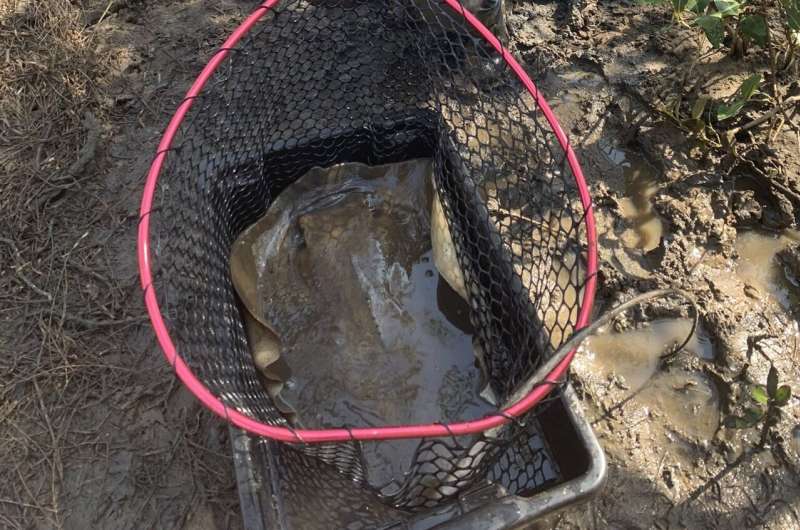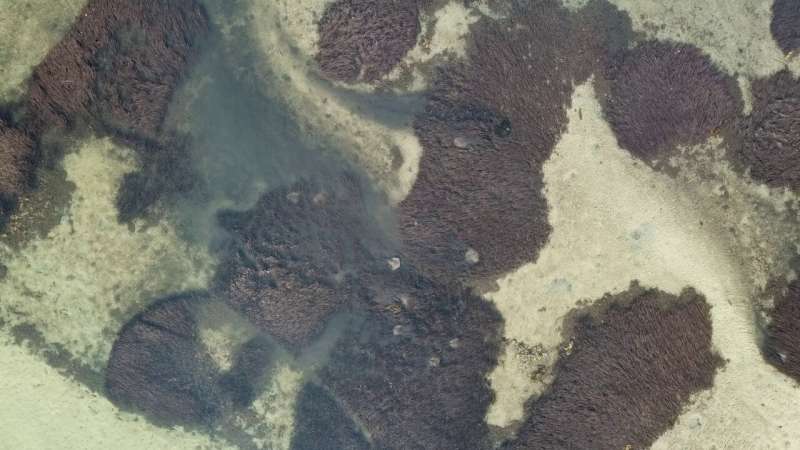This article has been reviewed according to Science X's editorial process and policies. Editors have highlighted the following attributes while ensuring the content's credibility:
fact-checked
proofread
Scientists unearth stingrays' heavy lifting role in estuaries

A new study has uncovered the significant role stingrays play in shaping estuaries, revealing threatened stingrays in Brisbane Water may move more than 21,000 tonnes of sand per year.
University of Newcastle Ph.D. student Molly Grew, who led the study, said stingrays in NSW's Brisbane Water estuary displaced a similar mass of sand each year to that of the Great Sphinx of Giza in Egypt.
"When feeding and sleeping, stingrays create pits that look like shallow divots in the ocean floor. We know that this process helps with oxygen penetration in the sand, which many organisms rely on," Molly said.
Pits appear when stingrays forage for food on the ocean floor, and when they bury themselves beneath the surface of the sand to rest—hidden from predators.
"The goal of this research was to understand the magnitude of sand turnover by stingrays to better understand how the estuary ecosystem works," Molly said.
Estuary Stingrays in Brisbane Water are listed as near threatened with their population declining.
"Fewer stingrays would mean a decline in sand turnover. With less turnover, sand would become more anoxic—lacking in oxygen. This would impact the survival of some creatures.
"If stingray populations continue to decline, we'd likely see flow-on effects up the food chain which would ultimately impact recreational and commercial fishing," Molly said.

Published in the journal Remote Sensing in Ecology and Conservation, this is the first study to combine drones, aerial imagery and 3D modeling to map topography and identify stingray feeding pits on the estuary floor.
To understand how quickly new pits emerge, Molly said she conducted daily drone surveys of Brisbane Water at sunrise over the course of a week.
By combining the drone photographs with specialized software, Molly made 3D models of the sand surface to accurately measure the volume displaced, and then extrapolated that pattern across the estuary. Until now, methods for counting stingray pits were laborious and resource intense.
"This is the first-time drone imagery has been used to measure stingray pits in 3D," Molly said.
With the stingray population unknown, Molly's Ph.D. Supervisor, ecologist Dr. Vincent Raoult said this study was important to shed light on the species. "Research like this is vital to highlight the significant role stingrays have in shaping estuary ecosystems, and to raise awareness of why their conservation is important," Dr. Raoult said.
Alongside Dr. Raoult, Dr. Andrea Griffin and Associate Professor Troy Gaston from the University of Newcastle's School of Environmental and Life Sciences supervised this research project with contribution from spatial science Senior Lecturer, Dr. Stephanie Duce from James Cook University.
Endemic to Australia, Estuary Stingrays are under threat from habitat degradation, urban development in sand, toxic runoff into estuaries, and dredging.
"They are found in estuary environments near human populations which puts them naturally at risk," Dr. Raoult said.
"This study has shown rays probably displace about 60 tons of sand per day in Brisbane Waters. This really puts into perspective how much these animals are shaping the estuaries we live next to. We need to cherish and value these animals and their estuary home."
More information: Molly Grew et al, Ray bioturbation rates suggest they shape estuary processes, Remote Sensing in Ecology and Conservation (2024). DOI: 10.1002/rse2.411
Provided by University of Newcastle

















